Comprehensive Financial Analysis Report: Berjaya Food Berhad
VerifiedAdded on 2020/12/09
|10
|3011
|168
Report
AI Summary
This report presents a financial analysis of Berjaya Food Berhad, a Malaysian investment holding company operating in the food and beverage sector. The analysis focuses on interpreting financial statements and calculating key financial ratios, including quick, current, profitability, and efficiency ratios. The report evaluates the company's performance from 2016 to 2017, comparing its financial metrics to industry benchmarks. It examines the company's subsidiaries, such as Starbucks Coffee and Kenny Rogers Roasters, and their impact on overall financial health. The analysis covers liquidity, profitability, and efficiency, assessing the company's ability to manage its assets and generate income. The report concludes with recommendations for improving financial performance and achieving sustainable growth.
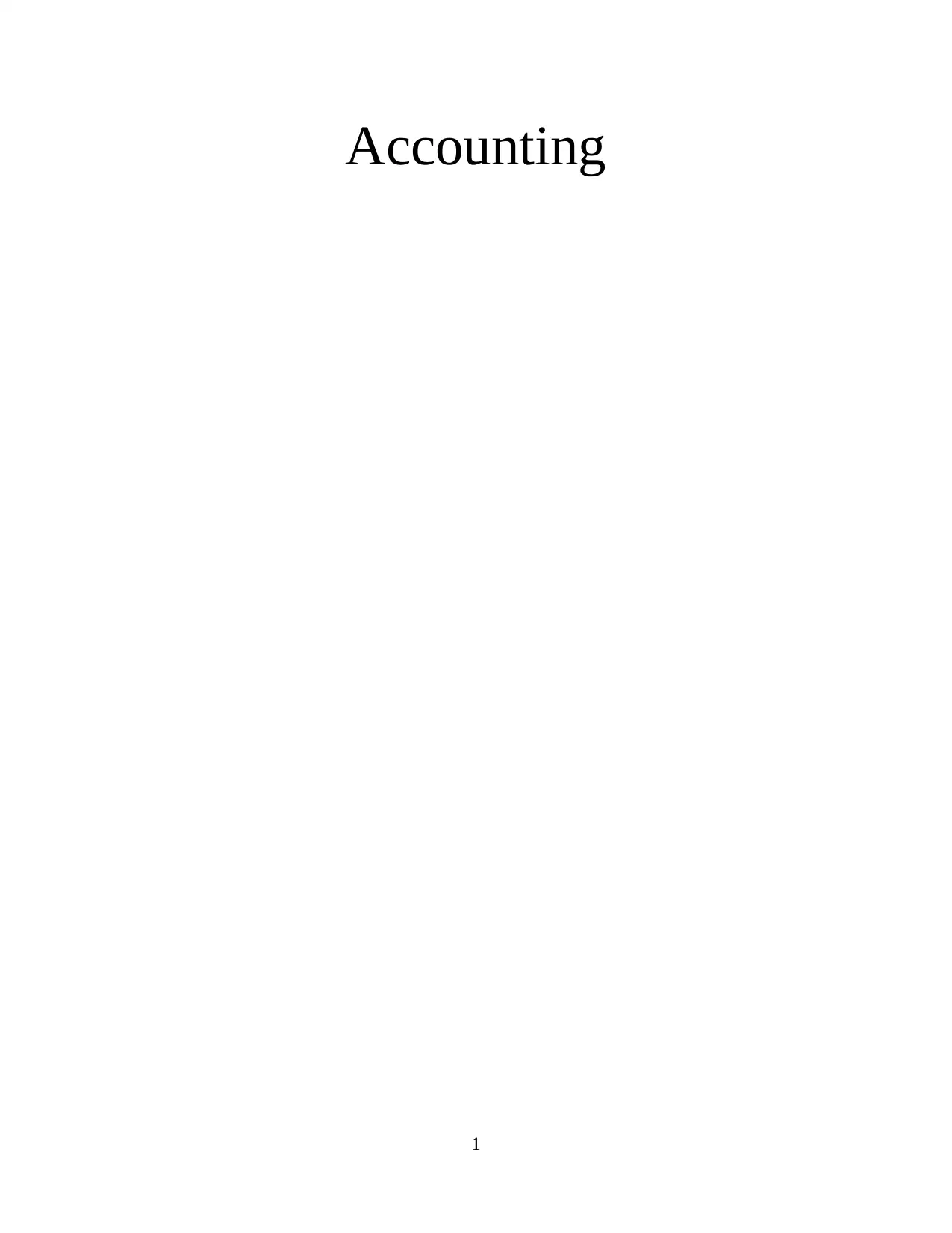
Accounting
1
1
Paraphrase This Document
Need a fresh take? Get an instant paraphrase of this document with our AI Paraphraser
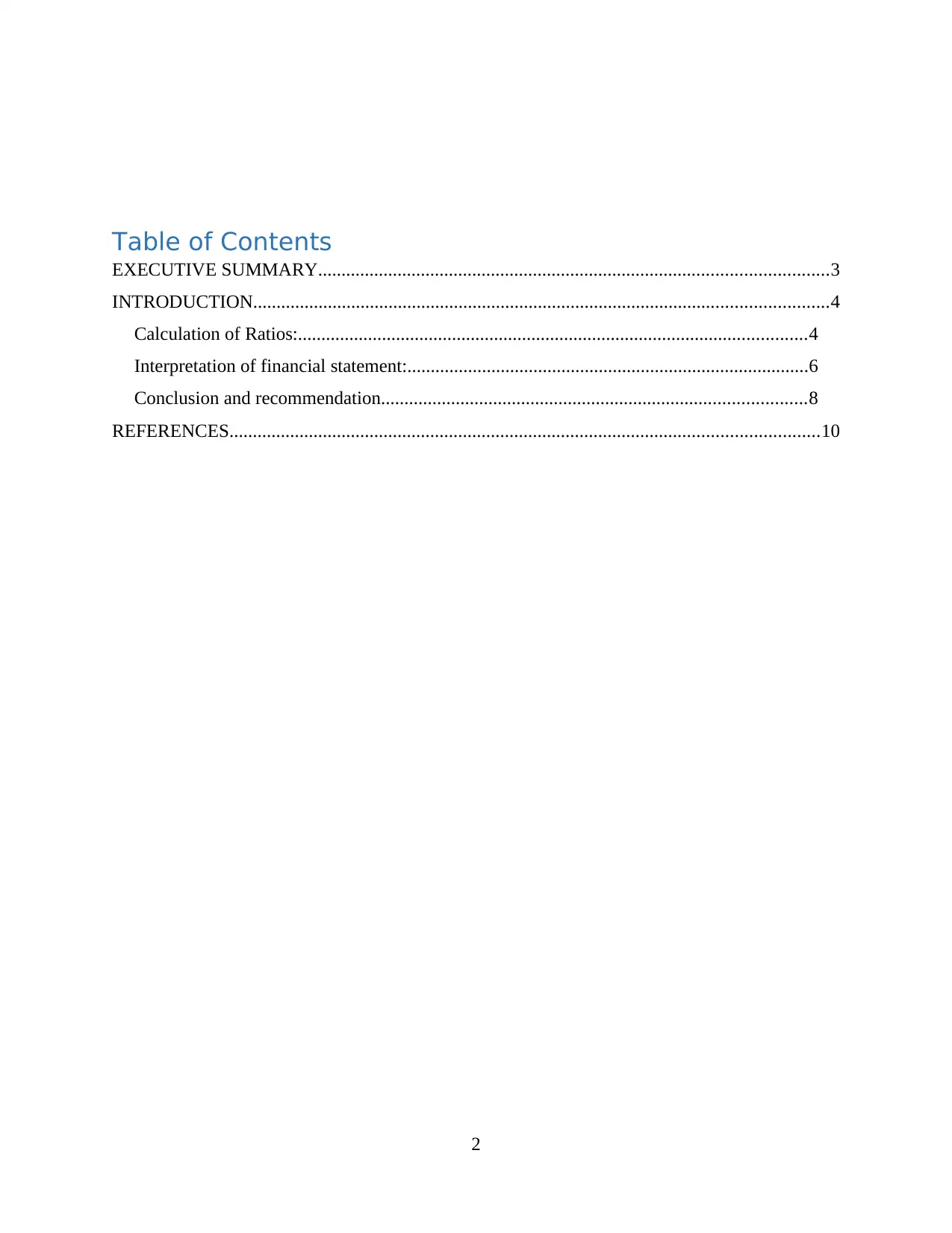
Table of Contents
EXECUTIVE SUMMARY.............................................................................................................3
INTRODUCTION...........................................................................................................................4
Calculation of Ratios:.............................................................................................................4
Interpretation of financial statement:......................................................................................6
Conclusion and recommendation...........................................................................................8
REFERENCES..............................................................................................................................10
2
EXECUTIVE SUMMARY.............................................................................................................3
INTRODUCTION...........................................................................................................................4
Calculation of Ratios:.............................................................................................................4
Interpretation of financial statement:......................................................................................6
Conclusion and recommendation...........................................................................................8
REFERENCES..............................................................................................................................10
2
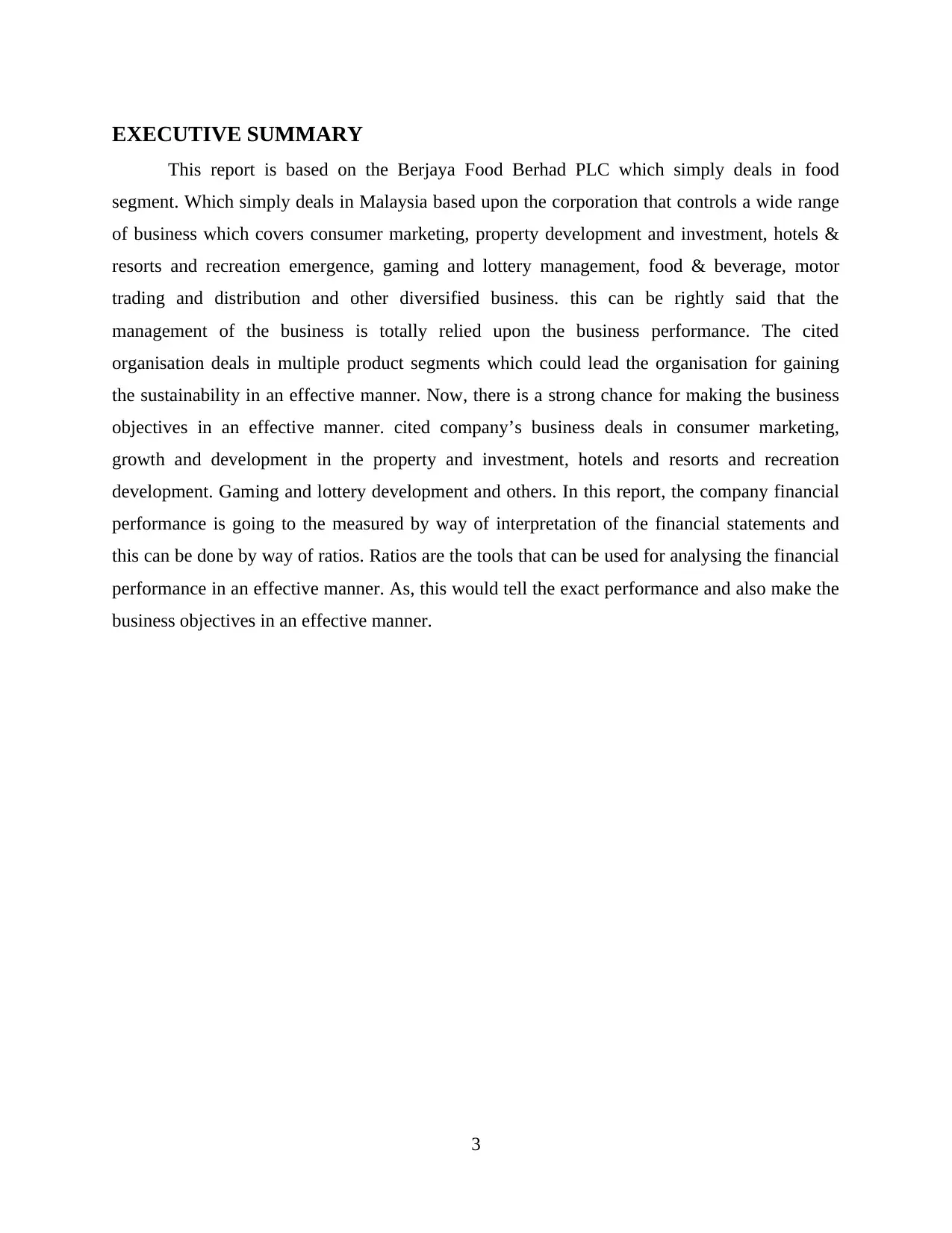
EXECUTIVE SUMMARY
This report is based on the Berjaya Food Berhad PLC which simply deals in food
segment. Which simply deals in Malaysia based upon the corporation that controls a wide range
of business which covers consumer marketing, property development and investment, hotels &
resorts and recreation emergence, gaming and lottery management, food & beverage, motor
trading and distribution and other diversified business. this can be rightly said that the
management of the business is totally relied upon the business performance. The cited
organisation deals in multiple product segments which could lead the organisation for gaining
the sustainability in an effective manner. Now, there is a strong chance for making the business
objectives in an effective manner. cited company’s business deals in consumer marketing,
growth and development in the property and investment, hotels and resorts and recreation
development. Gaming and lottery development and others. In this report, the company financial
performance is going to the measured by way of interpretation of the financial statements and
this can be done by way of ratios. Ratios are the tools that can be used for analysing the financial
performance in an effective manner. As, this would tell the exact performance and also make the
business objectives in an effective manner.
3
This report is based on the Berjaya Food Berhad PLC which simply deals in food
segment. Which simply deals in Malaysia based upon the corporation that controls a wide range
of business which covers consumer marketing, property development and investment, hotels &
resorts and recreation emergence, gaming and lottery management, food & beverage, motor
trading and distribution and other diversified business. this can be rightly said that the
management of the business is totally relied upon the business performance. The cited
organisation deals in multiple product segments which could lead the organisation for gaining
the sustainability in an effective manner. Now, there is a strong chance for making the business
objectives in an effective manner. cited company’s business deals in consumer marketing,
growth and development in the property and investment, hotels and resorts and recreation
development. Gaming and lottery development and others. In this report, the company financial
performance is going to the measured by way of interpretation of the financial statements and
this can be done by way of ratios. Ratios are the tools that can be used for analysing the financial
performance in an effective manner. As, this would tell the exact performance and also make the
business objectives in an effective manner.
3
⊘ This is a preview!⊘
Do you want full access?
Subscribe today to unlock all pages.

Trusted by 1+ million students worldwide
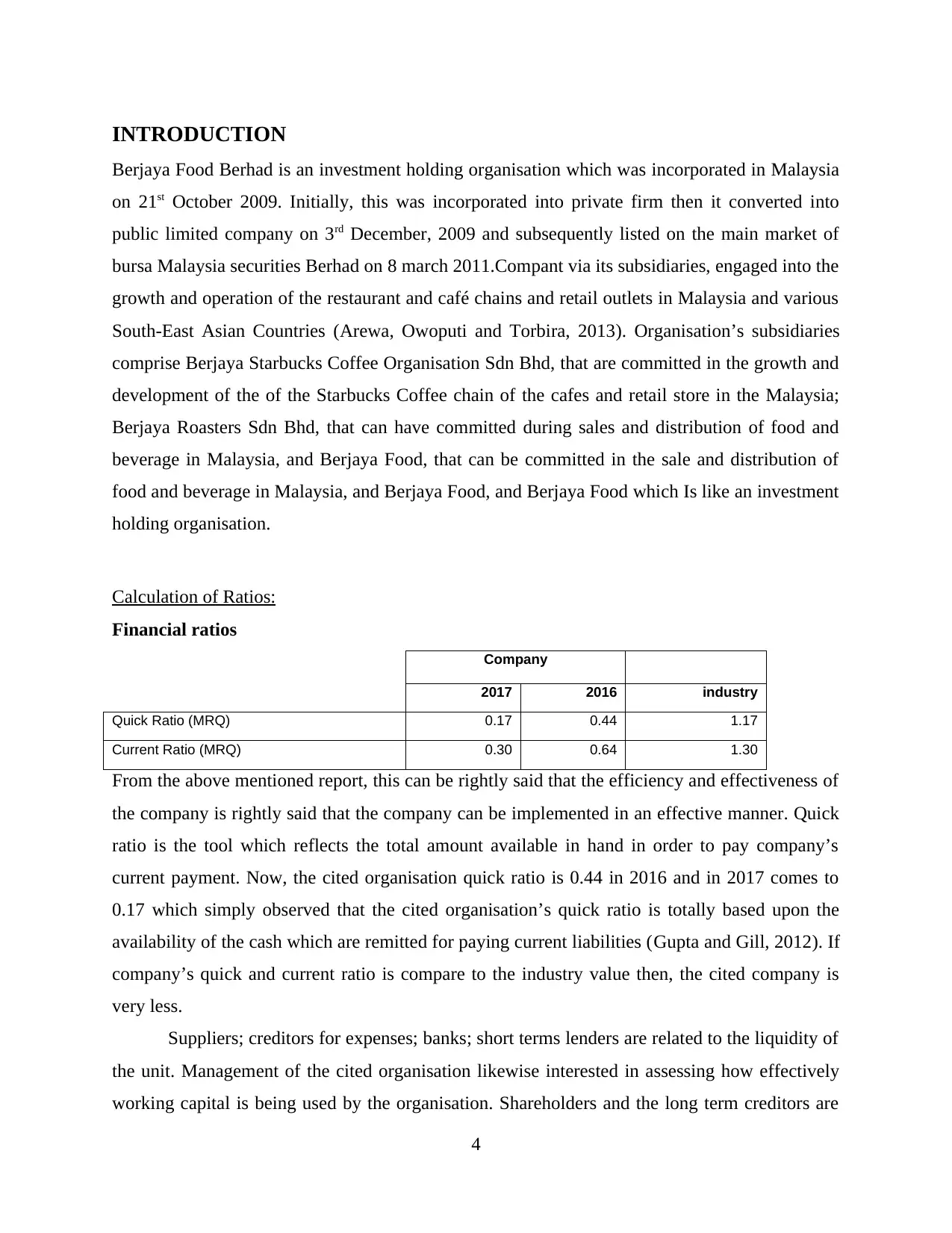
INTRODUCTION
Berjaya Food Berhad is an investment holding organisation which was incorporated in Malaysia
on 21st October 2009. Initially, this was incorporated into private firm then it converted into
public limited company on 3rd December, 2009 and subsequently listed on the main market of
bursa Malaysia securities Berhad on 8 march 2011.Compant via its subsidiaries, engaged into the
growth and operation of the restaurant and café chains and retail outlets in Malaysia and various
South-East Asian Countries (Arewa, Owoputi and Torbira, 2013). Organisation’s subsidiaries
comprise Berjaya Starbucks Coffee Organisation Sdn Bhd, that are committed in the growth and
development of the of the Starbucks Coffee chain of the cafes and retail store in the Malaysia;
Berjaya Roasters Sdn Bhd, that can have committed during sales and distribution of food and
beverage in Malaysia, and Berjaya Food, that can be committed in the sale and distribution of
food and beverage in Malaysia, and Berjaya Food, and Berjaya Food which Is like an investment
holding organisation.
Calculation of Ratios:
Financial ratios
Company
2017 2016 industry
Quick Ratio (MRQ) 0.17 0.44 1.17
Current Ratio (MRQ) 0.30 0.64 1.30
From the above mentioned report, this can be rightly said that the efficiency and effectiveness of
the company is rightly said that the company can be implemented in an effective manner. Quick
ratio is the tool which reflects the total amount available in hand in order to pay company’s
current payment. Now, the cited organisation quick ratio is 0.44 in 2016 and in 2017 comes to
0.17 which simply observed that the cited organisation’s quick ratio is totally based upon the
availability of the cash which are remitted for paying current liabilities (Gupta and Gill, 2012). If
company’s quick and current ratio is compare to the industry value then, the cited company is
very less.
Suppliers; creditors for expenses; banks; short terms lenders are related to the liquidity of
the unit. Management of the cited organisation likewise interested in assessing how effectively
working capital is being used by the organisation. Shareholders and the long term creditors are
4
Berjaya Food Berhad is an investment holding organisation which was incorporated in Malaysia
on 21st October 2009. Initially, this was incorporated into private firm then it converted into
public limited company on 3rd December, 2009 and subsequently listed on the main market of
bursa Malaysia securities Berhad on 8 march 2011.Compant via its subsidiaries, engaged into the
growth and operation of the restaurant and café chains and retail outlets in Malaysia and various
South-East Asian Countries (Arewa, Owoputi and Torbira, 2013). Organisation’s subsidiaries
comprise Berjaya Starbucks Coffee Organisation Sdn Bhd, that are committed in the growth and
development of the of the Starbucks Coffee chain of the cafes and retail store in the Malaysia;
Berjaya Roasters Sdn Bhd, that can have committed during sales and distribution of food and
beverage in Malaysia, and Berjaya Food, that can be committed in the sale and distribution of
food and beverage in Malaysia, and Berjaya Food, and Berjaya Food which Is like an investment
holding organisation.
Calculation of Ratios:
Financial ratios
Company
2017 2016 industry
Quick Ratio (MRQ) 0.17 0.44 1.17
Current Ratio (MRQ) 0.30 0.64 1.30
From the above mentioned report, this can be rightly said that the efficiency and effectiveness of
the company is rightly said that the company can be implemented in an effective manner. Quick
ratio is the tool which reflects the total amount available in hand in order to pay company’s
current payment. Now, the cited organisation quick ratio is 0.44 in 2016 and in 2017 comes to
0.17 which simply observed that the cited organisation’s quick ratio is totally based upon the
availability of the cash which are remitted for paying current liabilities (Gupta and Gill, 2012). If
company’s quick and current ratio is compare to the industry value then, the cited company is
very less.
Suppliers; creditors for expenses; banks; short terms lenders are related to the liquidity of
the unit. Management of the cited organisation likewise interested in assessing how effectively
working capital is being used by the organisation. Shareholders and the long term creditors are
4
Paraphrase This Document
Need a fresh take? Get an instant paraphrase of this document with our AI Paraphraser
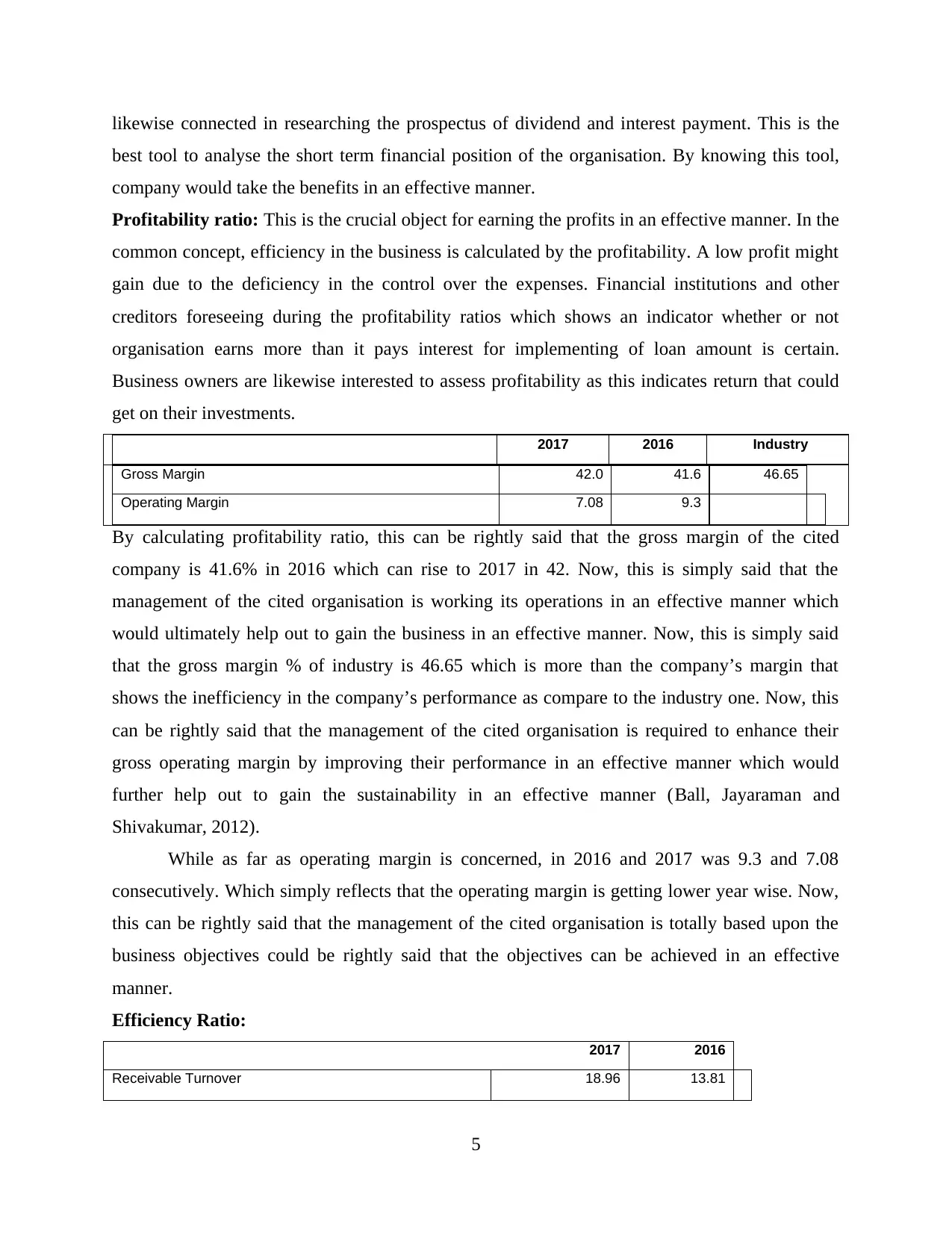
likewise connected in researching the prospectus of dividend and interest payment. This is the
best tool to analyse the short term financial position of the organisation. By knowing this tool,
company would take the benefits in an effective manner.
Profitability ratio: This is the crucial object for earning the profits in an effective manner. In the
common concept, efficiency in the business is calculated by the profitability. A low profit might
gain due to the deficiency in the control over the expenses. Financial institutions and other
creditors foreseeing during the profitability ratios which shows an indicator whether or not
organisation earns more than it pays interest for implementing of loan amount is certain.
Business owners are likewise interested to assess profitability as this indicates return that could
get on their investments.
2017 2016 Industry
Gross Margin 42.0 41.6 46.65
Operating Margin 7.08 9.3
By calculating profitability ratio, this can be rightly said that the gross margin of the cited
company is 41.6% in 2016 which can rise to 2017 in 42. Now, this is simply said that the
management of the cited organisation is working its operations in an effective manner which
would ultimately help out to gain the business in an effective manner. Now, this is simply said
that the gross margin % of industry is 46.65 which is more than the company’s margin that
shows the inefficiency in the company’s performance as compare to the industry one. Now, this
can be rightly said that the management of the cited organisation is required to enhance their
gross operating margin by improving their performance in an effective manner which would
further help out to gain the sustainability in an effective manner (Ball, Jayaraman and
Shivakumar, 2012).
While as far as operating margin is concerned, in 2016 and 2017 was 9.3 and 7.08
consecutively. Which simply reflects that the operating margin is getting lower year wise. Now,
this can be rightly said that the management of the cited organisation is totally based upon the
business objectives could be rightly said that the objectives can be achieved in an effective
manner.
Efficiency Ratio:
2017 2016
Receivable Turnover 18.96 13.81
5
best tool to analyse the short term financial position of the organisation. By knowing this tool,
company would take the benefits in an effective manner.
Profitability ratio: This is the crucial object for earning the profits in an effective manner. In the
common concept, efficiency in the business is calculated by the profitability. A low profit might
gain due to the deficiency in the control over the expenses. Financial institutions and other
creditors foreseeing during the profitability ratios which shows an indicator whether or not
organisation earns more than it pays interest for implementing of loan amount is certain.
Business owners are likewise interested to assess profitability as this indicates return that could
get on their investments.
2017 2016 Industry
Gross Margin 42.0 41.6 46.65
Operating Margin 7.08 9.3
By calculating profitability ratio, this can be rightly said that the gross margin of the cited
company is 41.6% in 2016 which can rise to 2017 in 42. Now, this is simply said that the
management of the cited organisation is working its operations in an effective manner which
would ultimately help out to gain the business in an effective manner. Now, this is simply said
that the gross margin % of industry is 46.65 which is more than the company’s margin that
shows the inefficiency in the company’s performance as compare to the industry one. Now, this
can be rightly said that the management of the cited organisation is required to enhance their
gross operating margin by improving their performance in an effective manner which would
further help out to gain the sustainability in an effective manner (Ball, Jayaraman and
Shivakumar, 2012).
While as far as operating margin is concerned, in 2016 and 2017 was 9.3 and 7.08
consecutively. Which simply reflects that the operating margin is getting lower year wise. Now,
this can be rightly said that the management of the cited organisation is totally based upon the
business objectives could be rightly said that the objectives can be achieved in an effective
manner.
Efficiency Ratio:
2017 2016
Receivable Turnover 18.96 13.81
5
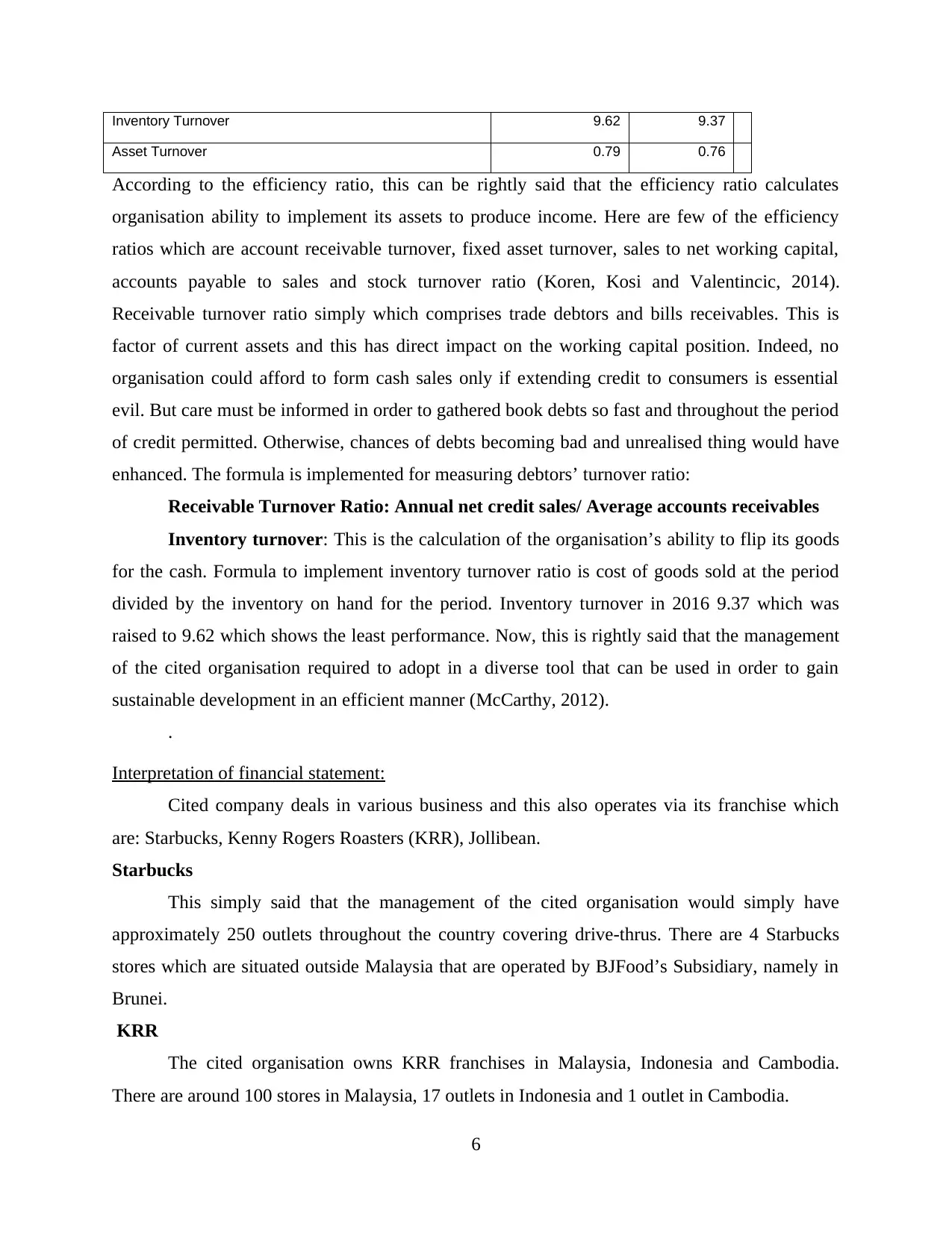
Inventory Turnover 9.62 9.37
Asset Turnover 0.79 0.76
According to the efficiency ratio, this can be rightly said that the efficiency ratio calculates
organisation ability to implement its assets to produce income. Here are few of the efficiency
ratios which are account receivable turnover, fixed asset turnover, sales to net working capital,
accounts payable to sales and stock turnover ratio (Koren, Kosi and Valentincic, 2014).
Receivable turnover ratio simply which comprises trade debtors and bills receivables. This is
factor of current assets and this has direct impact on the working capital position. Indeed, no
organisation could afford to form cash sales only if extending credit to consumers is essential
evil. But care must be informed in order to gathered book debts so fast and throughout the period
of credit permitted. Otherwise, chances of debts becoming bad and unrealised thing would have
enhanced. The formula is implemented for measuring debtors’ turnover ratio:
Receivable Turnover Ratio: Annual net credit sales/ Average accounts receivables
Inventory turnover: This is the calculation of the organisation’s ability to flip its goods
for the cash. Formula to implement inventory turnover ratio is cost of goods sold at the period
divided by the inventory on hand for the period. Inventory turnover in 2016 9.37 which was
raised to 9.62 which shows the least performance. Now, this is rightly said that the management
of the cited organisation required to adopt in a diverse tool that can be used in order to gain
sustainable development in an efficient manner (McCarthy, 2012).
.
Interpretation of financial statement:
Cited company deals in various business and this also operates via its franchise which
are: Starbucks, Kenny Rogers Roasters (KRR), Jollibean.
Starbucks
This simply said that the management of the cited organisation would simply have
approximately 250 outlets throughout the country covering drive-thrus. There are 4 Starbucks
stores which are situated outside Malaysia that are operated by BJFood’s Subsidiary, namely in
Brunei.
KRR
The cited organisation owns KRR franchises in Malaysia, Indonesia and Cambodia.
There are around 100 stores in Malaysia, 17 outlets in Indonesia and 1 outlet in Cambodia.
6
Asset Turnover 0.79 0.76
According to the efficiency ratio, this can be rightly said that the efficiency ratio calculates
organisation ability to implement its assets to produce income. Here are few of the efficiency
ratios which are account receivable turnover, fixed asset turnover, sales to net working capital,
accounts payable to sales and stock turnover ratio (Koren, Kosi and Valentincic, 2014).
Receivable turnover ratio simply which comprises trade debtors and bills receivables. This is
factor of current assets and this has direct impact on the working capital position. Indeed, no
organisation could afford to form cash sales only if extending credit to consumers is essential
evil. But care must be informed in order to gathered book debts so fast and throughout the period
of credit permitted. Otherwise, chances of debts becoming bad and unrealised thing would have
enhanced. The formula is implemented for measuring debtors’ turnover ratio:
Receivable Turnover Ratio: Annual net credit sales/ Average accounts receivables
Inventory turnover: This is the calculation of the organisation’s ability to flip its goods
for the cash. Formula to implement inventory turnover ratio is cost of goods sold at the period
divided by the inventory on hand for the period. Inventory turnover in 2016 9.37 which was
raised to 9.62 which shows the least performance. Now, this is rightly said that the management
of the cited organisation required to adopt in a diverse tool that can be used in order to gain
sustainable development in an efficient manner (McCarthy, 2012).
.
Interpretation of financial statement:
Cited company deals in various business and this also operates via its franchise which
are: Starbucks, Kenny Rogers Roasters (KRR), Jollibean.
Starbucks
This simply said that the management of the cited organisation would simply have
approximately 250 outlets throughout the country covering drive-thrus. There are 4 Starbucks
stores which are situated outside Malaysia that are operated by BJFood’s Subsidiary, namely in
Brunei.
KRR
The cited organisation owns KRR franchises in Malaysia, Indonesia and Cambodia.
There are around 100 stores in Malaysia, 17 outlets in Indonesia and 1 outlet in Cambodia.
6
⊘ This is a preview!⊘
Do you want full access?
Subscribe today to unlock all pages.

Trusted by 1+ million students worldwide
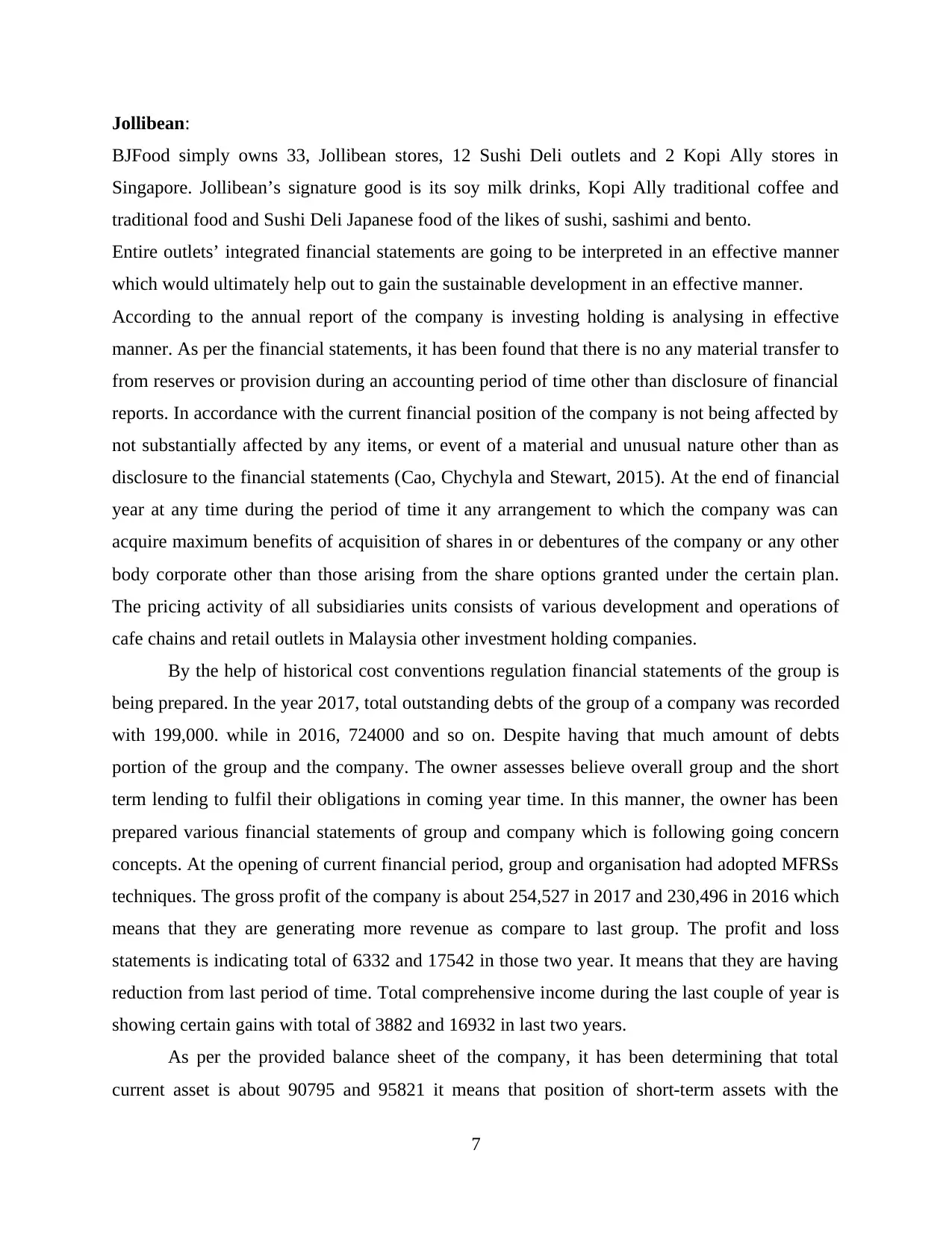
Jollibean:
BJFood simply owns 33, Jollibean stores, 12 Sushi Deli outlets and 2 Kopi Ally stores in
Singapore. Jollibean’s signature good is its soy milk drinks, Kopi Ally traditional coffee and
traditional food and Sushi Deli Japanese food of the likes of sushi, sashimi and bento.
Entire outlets’ integrated financial statements are going to be interpreted in an effective manner
which would ultimately help out to gain the sustainable development in an effective manner.
According to the annual report of the company is investing holding is analysing in effective
manner. As per the financial statements, it has been found that there is no any material transfer to
from reserves or provision during an accounting period of time other than disclosure of financial
reports. In accordance with the current financial position of the company is not being affected by
not substantially affected by any items, or event of a material and unusual nature other than as
disclosure to the financial statements (Cao, Chychyla and Stewart, 2015). At the end of financial
year at any time during the period of time it any arrangement to which the company was can
acquire maximum benefits of acquisition of shares in or debentures of the company or any other
body corporate other than those arising from the share options granted under the certain plan.
The pricing activity of all subsidiaries units consists of various development and operations of
cafe chains and retail outlets in Malaysia other investment holding companies.
By the help of historical cost conventions regulation financial statements of the group is
being prepared. In the year 2017, total outstanding debts of the group of a company was recorded
with 199,000. while in 2016, 724000 and so on. Despite having that much amount of debts
portion of the group and the company. The owner assesses believe overall group and the short
term lending to fulfil their obligations in coming year time. In this manner, the owner has been
prepared various financial statements of group and company which is following going concern
concepts. At the opening of current financial period, group and organisation had adopted MFRSs
techniques. The gross profit of the company is about 254,527 in 2017 and 230,496 in 2016 which
means that they are generating more revenue as compare to last group. The profit and loss
statements is indicating total of 6332 and 17542 in those two year. It means that they are having
reduction from last period of time. Total comprehensive income during the last couple of year is
showing certain gains with total of 3882 and 16932 in last two years.
As per the provided balance sheet of the company, it has been determining that total
current asset is about 90795 and 95821 it means that position of short-term assets with the
7
BJFood simply owns 33, Jollibean stores, 12 Sushi Deli outlets and 2 Kopi Ally stores in
Singapore. Jollibean’s signature good is its soy milk drinks, Kopi Ally traditional coffee and
traditional food and Sushi Deli Japanese food of the likes of sushi, sashimi and bento.
Entire outlets’ integrated financial statements are going to be interpreted in an effective manner
which would ultimately help out to gain the sustainable development in an effective manner.
According to the annual report of the company is investing holding is analysing in effective
manner. As per the financial statements, it has been found that there is no any material transfer to
from reserves or provision during an accounting period of time other than disclosure of financial
reports. In accordance with the current financial position of the company is not being affected by
not substantially affected by any items, or event of a material and unusual nature other than as
disclosure to the financial statements (Cao, Chychyla and Stewart, 2015). At the end of financial
year at any time during the period of time it any arrangement to which the company was can
acquire maximum benefits of acquisition of shares in or debentures of the company or any other
body corporate other than those arising from the share options granted under the certain plan.
The pricing activity of all subsidiaries units consists of various development and operations of
cafe chains and retail outlets in Malaysia other investment holding companies.
By the help of historical cost conventions regulation financial statements of the group is
being prepared. In the year 2017, total outstanding debts of the group of a company was recorded
with 199,000. while in 2016, 724000 and so on. Despite having that much amount of debts
portion of the group and the company. The owner assesses believe overall group and the short
term lending to fulfil their obligations in coming year time. In this manner, the owner has been
prepared various financial statements of group and company which is following going concern
concepts. At the opening of current financial period, group and organisation had adopted MFRSs
techniques. The gross profit of the company is about 254,527 in 2017 and 230,496 in 2016 which
means that they are generating more revenue as compare to last group. The profit and loss
statements is indicating total of 6332 and 17542 in those two year. It means that they are having
reduction from last period of time. Total comprehensive income during the last couple of year is
showing certain gains with total of 3882 and 16932 in last two years.
As per the provided balance sheet of the company, it has been determining that total
current asset is about 90795 and 95821 it means that position of short-term assets with the
7
Paraphrase This Document
Need a fresh take? Get an instant paraphrase of this document with our AI Paraphraser
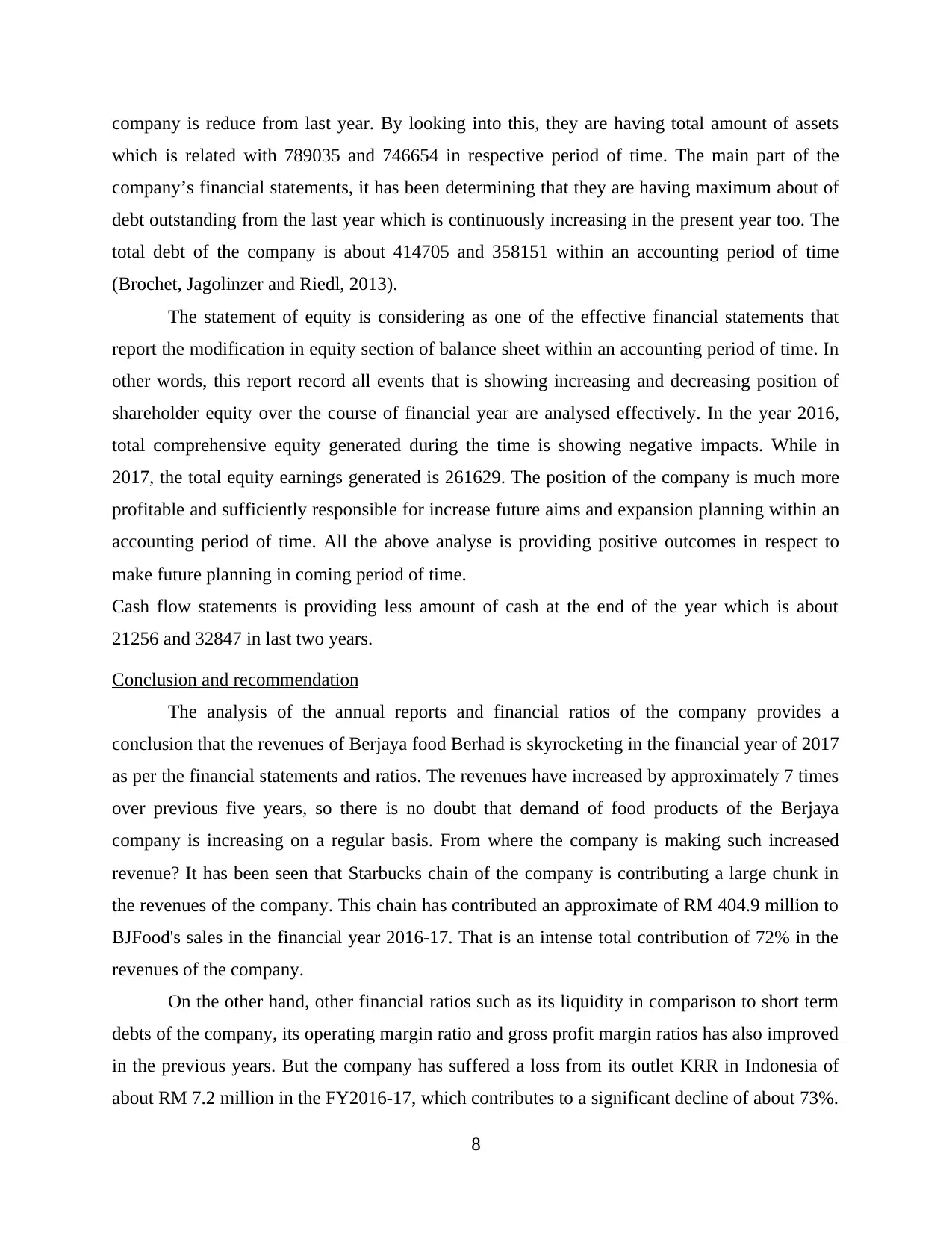
company is reduce from last year. By looking into this, they are having total amount of assets
which is related with 789035 and 746654 in respective period of time. The main part of the
company’s financial statements, it has been determining that they are having maximum about of
debt outstanding from the last year which is continuously increasing in the present year too. The
total debt of the company is about 414705 and 358151 within an accounting period of time
(Brochet, Jagolinzer and Riedl, 2013).
The statement of equity is considering as one of the effective financial statements that
report the modification in equity section of balance sheet within an accounting period of time. In
other words, this report record all events that is showing increasing and decreasing position of
shareholder equity over the course of financial year are analysed effectively. In the year 2016,
total comprehensive equity generated during the time is showing negative impacts. While in
2017, the total equity earnings generated is 261629. The position of the company is much more
profitable and sufficiently responsible for increase future aims and expansion planning within an
accounting period of time. All the above analyse is providing positive outcomes in respect to
make future planning in coming period of time.
Cash flow statements is providing less amount of cash at the end of the year which is about
21256 and 32847 in last two years.
Conclusion and recommendation
The analysis of the annual reports and financial ratios of the company provides a
conclusion that the revenues of Berjaya food Berhad is skyrocketing in the financial year of 2017
as per the financial statements and ratios. The revenues have increased by approximately 7 times
over previous five years, so there is no doubt that demand of food products of the Berjaya
company is increasing on a regular basis. From where the company is making such increased
revenue? It has been seen that Starbucks chain of the company is contributing a large chunk in
the revenues of the company. This chain has contributed an approximate of RM 404.9 million to
BJFood's sales in the financial year 2016-17. That is an intense total contribution of 72% in the
revenues of the company.
On the other hand, other financial ratios such as its liquidity in comparison to short term
debts of the company, its operating margin ratio and gross profit margin ratios has also improved
in the previous years. But the company has suffered a loss from its outlet KRR in Indonesia of
about RM 7.2 million in the FY2016-17, which contributes to a significant decline of about 73%.
8
which is related with 789035 and 746654 in respective period of time. The main part of the
company’s financial statements, it has been determining that they are having maximum about of
debt outstanding from the last year which is continuously increasing in the present year too. The
total debt of the company is about 414705 and 358151 within an accounting period of time
(Brochet, Jagolinzer and Riedl, 2013).
The statement of equity is considering as one of the effective financial statements that
report the modification in equity section of balance sheet within an accounting period of time. In
other words, this report record all events that is showing increasing and decreasing position of
shareholder equity over the course of financial year are analysed effectively. In the year 2016,
total comprehensive equity generated during the time is showing negative impacts. While in
2017, the total equity earnings generated is 261629. The position of the company is much more
profitable and sufficiently responsible for increase future aims and expansion planning within an
accounting period of time. All the above analyse is providing positive outcomes in respect to
make future planning in coming period of time.
Cash flow statements is providing less amount of cash at the end of the year which is about
21256 and 32847 in last two years.
Conclusion and recommendation
The analysis of the annual reports and financial ratios of the company provides a
conclusion that the revenues of Berjaya food Berhad is skyrocketing in the financial year of 2017
as per the financial statements and ratios. The revenues have increased by approximately 7 times
over previous five years, so there is no doubt that demand of food products of the Berjaya
company is increasing on a regular basis. From where the company is making such increased
revenue? It has been seen that Starbucks chain of the company is contributing a large chunk in
the revenues of the company. This chain has contributed an approximate of RM 404.9 million to
BJFood's sales in the financial year 2016-17. That is an intense total contribution of 72% in the
revenues of the company.
On the other hand, other financial ratios such as its liquidity in comparison to short term
debts of the company, its operating margin ratio and gross profit margin ratios has also improved
in the previous years. But the company has suffered a loss from its outlet KRR in Indonesia of
about RM 7.2 million in the FY2016-17, which contributes to a significant decline of about 73%.
8
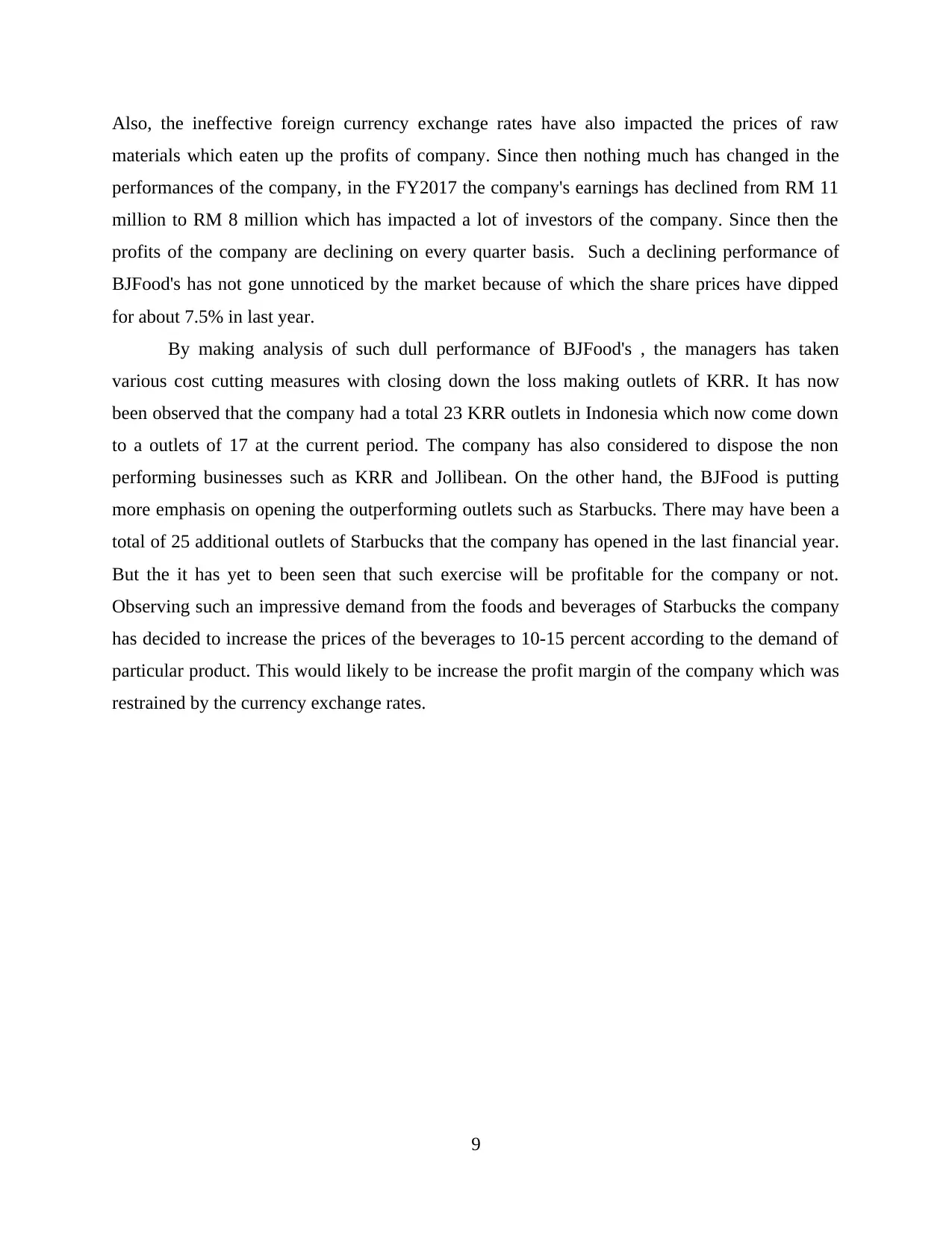
Also, the ineffective foreign currency exchange rates have also impacted the prices of raw
materials which eaten up the profits of company. Since then nothing much has changed in the
performances of the company, in the FY2017 the company's earnings has declined from RM 11
million to RM 8 million which has impacted a lot of investors of the company. Since then the
profits of the company are declining on every quarter basis. Such a declining performance of
BJFood's has not gone unnoticed by the market because of which the share prices have dipped
for about 7.5% in last year.
By making analysis of such dull performance of BJFood's , the managers has taken
various cost cutting measures with closing down the loss making outlets of KRR. It has now
been observed that the company had a total 23 KRR outlets in Indonesia which now come down
to a outlets of 17 at the current period. The company has also considered to dispose the non
performing businesses such as KRR and Jollibean. On the other hand, the BJFood is putting
more emphasis on opening the outperforming outlets such as Starbucks. There may have been a
total of 25 additional outlets of Starbucks that the company has opened in the last financial year.
But the it has yet to been seen that such exercise will be profitable for the company or not.
Observing such an impressive demand from the foods and beverages of Starbucks the company
has decided to increase the prices of the beverages to 10-15 percent according to the demand of
particular product. This would likely to be increase the profit margin of the company which was
restrained by the currency exchange rates.
9
materials which eaten up the profits of company. Since then nothing much has changed in the
performances of the company, in the FY2017 the company's earnings has declined from RM 11
million to RM 8 million which has impacted a lot of investors of the company. Since then the
profits of the company are declining on every quarter basis. Such a declining performance of
BJFood's has not gone unnoticed by the market because of which the share prices have dipped
for about 7.5% in last year.
By making analysis of such dull performance of BJFood's , the managers has taken
various cost cutting measures with closing down the loss making outlets of KRR. It has now
been observed that the company had a total 23 KRR outlets in Indonesia which now come down
to a outlets of 17 at the current period. The company has also considered to dispose the non
performing businesses such as KRR and Jollibean. On the other hand, the BJFood is putting
more emphasis on opening the outperforming outlets such as Starbucks. There may have been a
total of 25 additional outlets of Starbucks that the company has opened in the last financial year.
But the it has yet to been seen that such exercise will be profitable for the company or not.
Observing such an impressive demand from the foods and beverages of Starbucks the company
has decided to increase the prices of the beverages to 10-15 percent according to the demand of
particular product. This would likely to be increase the profit margin of the company which was
restrained by the currency exchange rates.
9
⊘ This is a preview!⊘
Do you want full access?
Subscribe today to unlock all pages.

Trusted by 1+ million students worldwide
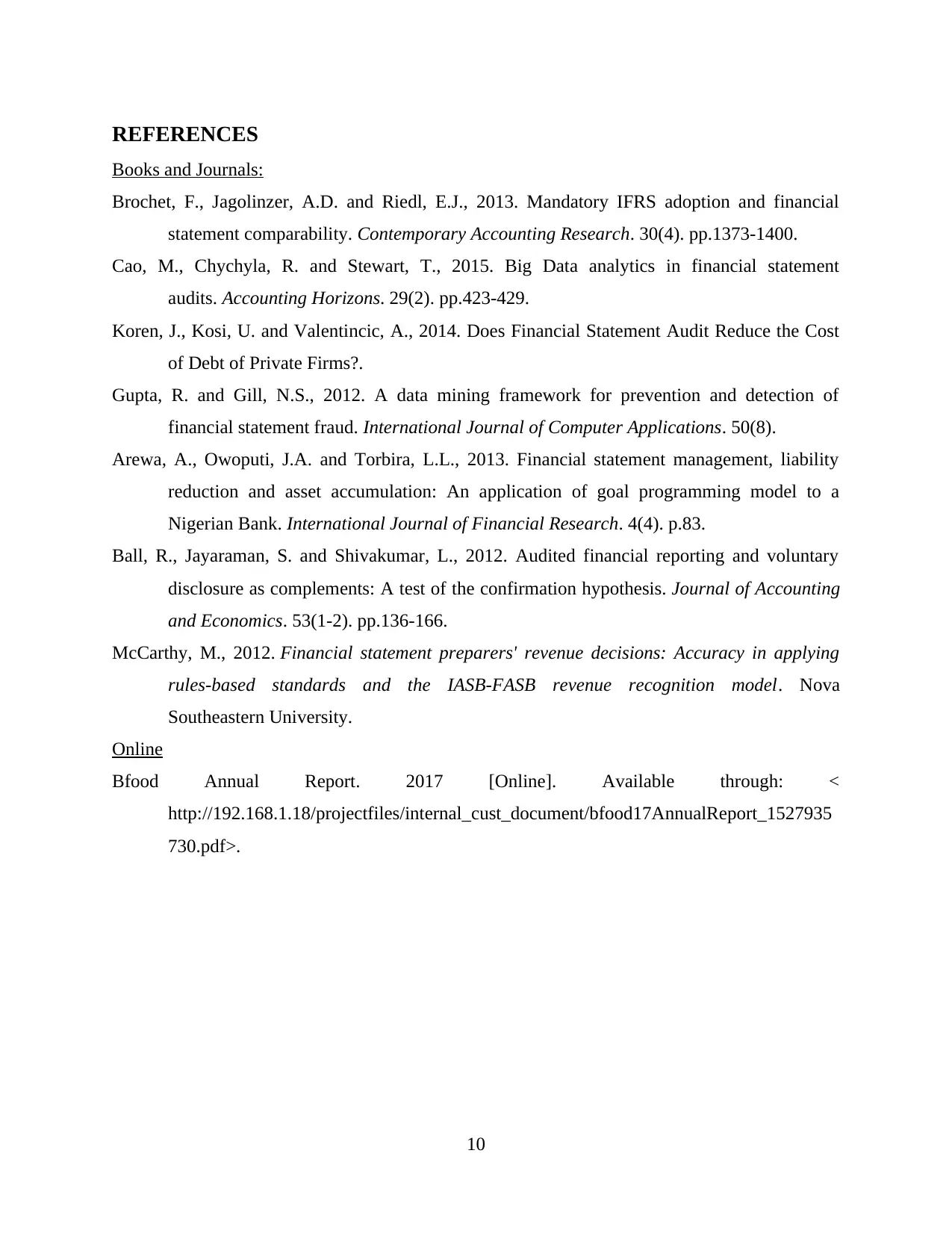
REFERENCES
Books and Journals:
Brochet, F., Jagolinzer, A.D. and Riedl, E.J., 2013. Mandatory IFRS adoption and financial
statement comparability. Contemporary Accounting Research. 30(4). pp.1373-1400.
Cao, M., Chychyla, R. and Stewart, T., 2015. Big Data analytics in financial statement
audits. Accounting Horizons. 29(2). pp.423-429.
Koren, J., Kosi, U. and Valentincic, A., 2014. Does Financial Statement Audit Reduce the Cost
of Debt of Private Firms?.
Gupta, R. and Gill, N.S., 2012. A data mining framework for prevention and detection of
financial statement fraud. International Journal of Computer Applications. 50(8).
Arewa, A., Owoputi, J.A. and Torbira, L.L., 2013. Financial statement management, liability
reduction and asset accumulation: An application of goal programming model to a
Nigerian Bank. International Journal of Financial Research. 4(4). p.83.
Ball, R., Jayaraman, S. and Shivakumar, L., 2012. Audited financial reporting and voluntary
disclosure as complements: A test of the confirmation hypothesis. Journal of Accounting
and Economics. 53(1-2). pp.136-166.
McCarthy, M., 2012. Financial statement preparers' revenue decisions: Accuracy in applying
rules-based standards and the IASB-FASB revenue recognition model. Nova
Southeastern University.
Online
Bfood Annual Report. 2017 [Online]. Available through: <
http://192.168.1.18/projectfiles/internal_cust_document/bfood17AnnualReport_1527935
730.pdf>.
10
Books and Journals:
Brochet, F., Jagolinzer, A.D. and Riedl, E.J., 2013. Mandatory IFRS adoption and financial
statement comparability. Contemporary Accounting Research. 30(4). pp.1373-1400.
Cao, M., Chychyla, R. and Stewart, T., 2015. Big Data analytics in financial statement
audits. Accounting Horizons. 29(2). pp.423-429.
Koren, J., Kosi, U. and Valentincic, A., 2014. Does Financial Statement Audit Reduce the Cost
of Debt of Private Firms?.
Gupta, R. and Gill, N.S., 2012. A data mining framework for prevention and detection of
financial statement fraud. International Journal of Computer Applications. 50(8).
Arewa, A., Owoputi, J.A. and Torbira, L.L., 2013. Financial statement management, liability
reduction and asset accumulation: An application of goal programming model to a
Nigerian Bank. International Journal of Financial Research. 4(4). p.83.
Ball, R., Jayaraman, S. and Shivakumar, L., 2012. Audited financial reporting and voluntary
disclosure as complements: A test of the confirmation hypothesis. Journal of Accounting
and Economics. 53(1-2). pp.136-166.
McCarthy, M., 2012. Financial statement preparers' revenue decisions: Accuracy in applying
rules-based standards and the IASB-FASB revenue recognition model. Nova
Southeastern University.
Online
Bfood Annual Report. 2017 [Online]. Available through: <
http://192.168.1.18/projectfiles/internal_cust_document/bfood17AnnualReport_1527935
730.pdf>.
10
1 out of 10
Your All-in-One AI-Powered Toolkit for Academic Success.
+13062052269
info@desklib.com
Available 24*7 on WhatsApp / Email
![[object Object]](/_next/static/media/star-bottom.7253800d.svg)
Unlock your academic potential
Copyright © 2020–2025 A2Z Services. All Rights Reserved. Developed and managed by ZUCOL.